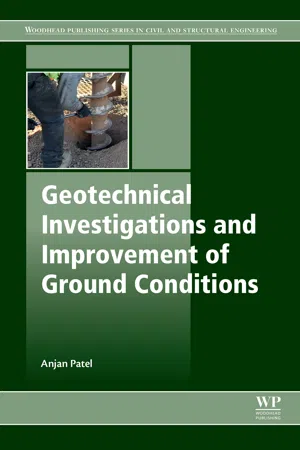
This is a test
- 209 pages
- English
- ePUB (mobile friendly)
- Available on iOS & Android
eBook - ePub
Geotechnical Investigations and Improvement of Ground Conditions
Book details
Book preview
Table of contents
Citations
About This Book
Geotechnical Investigation and Improvement of Ground Conditions covers practical information on ground improvement and site investigation, considering rock properties and engineering geology and its relation to construction. The book covers geotechnical investigation for construction projects, including classic case studies with geotechnical significance. Additional sections cover soil compaction, soil stabilization, drainage and dewatering, grouting methods, the stone column method, geotextiles, fabrics and earth reinforcement, miscellaneous methods and tools for ground improvement, geotechnical investigation for construction projects, and forensic geotechnical engineering. Final sections present a series of site-specific case studies.
- Dedicated to ground improvement techniques and geotechnical site investigation
- Provides practical guidance on site-specific geotechnical investigation and the subsequent interpretation of data
- Presents site-specific case studies with geotechnical significance
- Includes site investigation of soils and rocks
- Gives field-oriented information and guidance
Frequently asked questions
At the moment all of our mobile-responsive ePub books are available to download via the app. Most of our PDFs are also available to download and we're working on making the final remaining ones downloadable now. Learn more here.
Both plans give you full access to the library and all of Perlego’s features. The only differences are the price and subscription period: With the annual plan you’ll save around 30% compared to 12 months on the monthly plan.
We are an online textbook subscription service, where you can get access to an entire online library for less than the price of a single book per month. With over 1 million books across 1000+ topics, we’ve got you covered! Learn more here.
Look out for the read-aloud symbol on your next book to see if you can listen to it. The read-aloud tool reads text aloud for you, highlighting the text as it is being read. You can pause it, speed it up and slow it down. Learn more here.
Yes, you can access Geotechnical Investigations and Improvement of Ground Conditions by Anjan Patel in PDF and/or ePUB format, as well as other popular books in Technology & Engineering & Construction & Architectural Engineering. We have over one million books available in our catalogue for you to explore.
Information
1
Introduction
Abstract
Ground improvement is required, wherever problematic soils/rocks are encountered. The basic purpose is to make the subsurface conditions suitable for construction purposes. There are various methods of ground improvement available and the selection of a technique or a combination of techniques depends upon several factors. The different purposes of ground improvement and a brief description of the different methods and their selection criteria is presented in this chapter.
Keywords
Ground improvement; Bearing capacity; Lateral stability; Environmental control; Compaction; Consolidation; Soil reinforcement
1.1 Introduction
Ground improvement is required, wherever problematic soils/rocks are encountered. The basic purpose is to make the subsurface conditions suitable for construction purposes. There are various methods of ground improvement available and the selection of a technique or a combination of techniques depends upon several factors. The different purposes of ground improvement and a brief description of the different methods and their selection criteria is presented in this chapter.
1.1.1 Purpose of ground improvement
Ground-improvement methods are those that are capable of improving certain characteristics (e.g. increase in bearing capacity, reduction in total as well as differential settlement, reduction in permeability, slope stability, prevention of soil erosion caused by piping and seepage, reduction of uplift pressure, decrease in liquefaction potential of soil, reduction of swelling and cracking of soils, identification of suitability of site to facilitate construction works, etc.) of poor ground for civil engineering constructions and various infrastructure developments. So a ground improvement method or technique is required to alter the state, nature, or mass behaviour of ground materials in a controlled manner in order to achieve an expected and satisfactory response to existing or projected environmental and engineering actions.
There are alternate options to ground improvement as well. These are
- a. to remove and replace the soil mass with another type of soils or other geomaterials of a suitable quality for the construction work
- b. to bypass the poor soil with the help of a suitable technique like pile foundation
- c. to alter the design (height and configuration) of structures to overcome the ground limitations
- d. to change the construction site and look for a new one.
However, due to the scarcity of land in present conditions, heavy loading structures, competitive design, the need for speedy construction, and various political and economic issues, a ground-improvement technique may be the only feasible option for civil engineering constructions. This situation is outlined in Fig. 1.1, which demonstrates that when the ground is problematic in most of the cases we need to improve the soil mass by selecting a proper ground-improvement technique(s). The selection of ground-improvement techniques depends upon various factors like the cost and time available to complete the project, reasons for improving the ground, extent and...
Table of contents
- Cover image
- Title page
- Table of Contents
- Copyright
- 1: Introduction
- 2: Soil compaction
- 3: Soil stabilization
- 4: Drainage and dewatering
- 5: Grouting
- 6: Stone column method
- 7: Soil reinforcement
- 8: Miscellaneous methods
- 9: Geotechnical investigation
- 10: Forensic geotechnical engineering
- 11: Case examples of some geotechnical applications
- Index